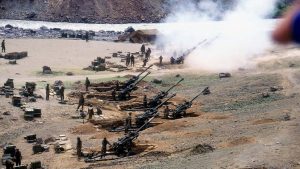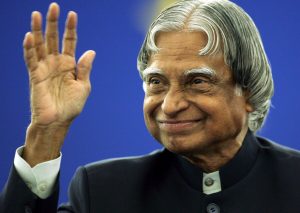 Prof. Satya Narayan Misra* in Bhubaneswar, June 16, 2023: The agreement signed between US President Biden and Indian PM Modi marks a new beginning in defense partnership between the two countries which was earlier governed by acquisitions and not technology transfer.
Prof. Satya Narayan Misra* in Bhubaneswar, June 16, 2023: The agreement signed between US President Biden and Indian PM Modi marks a new beginning in defense partnership between the two countries which was earlier governed by acquisitions and not technology transfer.
After the Chinese debacle in 1962, India consciously opted for a strategic defense partnership with the Soviet Union, with the induction of MIG21 aircraft and technology transfer thereof. Instead of boosting our R& D & design capability and Make in India, Nehru consciously opted for the Technology transfer route (Buy Technology & Make in India) as the predominant policy for building Military Industry Complex.
Be it frigates for the Navy, tanks for the Army, or fighter aircraft for IAF, it was USSR all the way. Nehru’s clear predilection for Socialism clearly drove our defense technology cooperation with USSR. The 1971 war with Pakistan, when the Nixon Administration took a stridently anti-Indian position by sending the 7th fleet, took the Indo-Soviet cooperation to a crescendo, inking the Indo-Soviet Treaty of Friendship & Cooperation.
No wonder close to 85% of defense inventory is of Russian origin. There have been outliers, though when India acquired the Jaguars from the UK in 1978 and Mirage2000 from France in 1982 as a riposte to Pakistan buying F16 aircraft from the US. Both in Jaguar and Mirage, there has been no provision for technology transfer.
Given India’s bitter experience with the Americans in the 1971 war, the civil nuclear agreement in 2005 between the two countries during the Manmohan regime can be termed a watershed turnaround moment. In weapon acquisition, the relationship has been largely driven by Foreign Military Sales (FMS) arrangements under the aegis of DSCA, where India gets its preferred military equipment sourced from the USA. Many of the frontline acquisitions like gun locating radar, surveillance aircraft, heavy lift aircraft have been sourced through the foreign military route accounting for nearly 20 billion dollars since 2002.
The popular impression has been that the USA doesn’t believe in technological collaboration and knowledge transfer, except to countries like Japan, Israel & South Korea, but as a seller of critical platforms and equipment. On the other hand, the Israelis who have benefited immensely due to their partnership with the USA have been the major supplier of arms & platforms to India. The Unmanned Aerial Vehicle (UAV) to all three services is a reflection of the growing military relationship with Israel.
 In communication devices, the Israelis have a near monopoly in supplying to the Indians. As a matter of fact, Israel has emerged as the 2nd most defense partner of India, particularly after the Kargil war when the AMRs to bust bunkers came in very handy. Given this backdrop, the MOU which has been signed for powering the LCA aircraft with a G414 engine and that 11 critical technologies would be transferred to HAL can be called historic. It is worth recalling that India ventured into the Kaveri engine program in 1986 to power the LCA aircraft with an indigenous engine.
In communication devices, the Israelis have a near monopoly in supplying to the Indians. As a matter of fact, Israel has emerged as the 2nd most defense partner of India, particularly after the Kargil war when the AMRs to bust bunkers came in very handy. Given this backdrop, the MOU which has been signed for powering the LCA aircraft with a G414 engine and that 11 critical technologies would be transferred to HAL can be called historic. It is worth recalling that India ventured into the Kaveri engine program in 1986 to power the LCA aircraft with an indigenous engine.
However, due to its design failure after auditing by Snecma, the initial LCA prototype aircraft are being powered by G404 engines. Against this backdrop, the proposed TOT collaboration for a G414 engine would be timely because India is only familiar with the technology of Russian engines. It may be noted that the DRDO is still going for an upgraded version of the Kaveri engine called Ghatak . Given our bitter experience in design & lack of adequate expertise, it would be far more advisable to have a technological collaboration with the USA for engines.
It would, however, be necessary to have a proper assessment of the range & depth of technology being transferred and to what extent HAL would be able to absorb the critical technologies like special coating & FADEC ( Full Automatic Digital Engine Control) The other collaboration being envisaged is to make India a hub for Maintenance & Repair for forward deployed US Navy assets & Master Ship Repair agreements with Indian shipyards.
Even for the UAVs, a comprehensive MRO facility in India is being contemplated. With our skilled power which is considerably cheaper than the Western counterparts ($8 MHR vs $60), Setting up an MRO facility in India is the most cost-effective & convenient.
The willingness of the USA to transfer critical technology was triggered by the MMRCA (Medium Multi Role Combat Aircraft (Buy & Make ) tender when President Obama during his India visit in 2010 promised to transfer key technologies of AESA (Active Electronically Scanned Array) radar as also the engine if F16 or F18 was chosen as the preferred aircraft. It’s ironic that the government, instead of exercising the Buy and Make option for MMRCA opted for Buying Rafale aircraft from France without any technology transfer.
 The policy preference for Make in India was supplanted by import leading to complaints regarding its high cost & potential corruption. The other highlight of the Biden-Modi agreement is India’s plan to procure thirty-one MQ9B predators from General Atomics at a cost of 3 billion dollars.
The policy preference for Make in India was supplanted by import leading to complaints regarding its high cost & potential corruption. The other highlight of the Biden-Modi agreement is India’s plan to procure thirty-one MQ9B predators from General Atomics at a cost of 3 billion dollars.
This is a major development since all the UAVs of the HALE variety have been procured from IAI Israel. MQ9B is a hunter killer UAV where it moves from surveillance, intelligence, and reconnaissance role to a hunter-killer role operating from a service ceiling of 50,000 feet as against 35000 feet of Israeli UAVs. This procurement would be a major game changer in India’s capability for surveillance coupled with lethality. A joint production of jet engines, long-range artillery, and ICVs is also being contemplated.
From being sellers, Americans have come a long way to become technology & production partners with India. The harsh reality of few competitors bidding for the same system as a cash-rich country like India, which wears patriotism on its sleeves has made the USA to be so benign in the matter of technology transfer. Of course, one should be sure that the technology being transferred is obsolete or state-of-the-art! DRDO, India’s premier agency for the design & development of critical systems, has a rather poor record in propulsion systems (Kaveri Engine), Sensors like AESA Radar & Weapons like Air to Air Missiles.
In the area of passive seekers, and focal plane array, DRDO’s record is dismal. Our import dependence for weapons, sensors & propulsion systems is almost 90%. That is mainly responsible for our Self Reliance Index of 30% calculated by the Kalam Committee in 1993, with a fond hope that we reach 70% by 2003.
A decade later, the SRI has not moved much, because of our design capability for critical subsystems, ability to have Coproduction arrangements with reputed OEMs (Original Equipment manufacturers, Joint R& D with well-known design houses have not moved at the requisite pace. The problem is further compounded by our inefficient Defence PSUs who have a poor record in terms of quality, delivery commitment & price.
The private players like the Tatas, L&T, and M&M still are pariahs in terms of access to critical technology. The level playing field which was championed by the Kelkar Committee in 2005 & further buttressed by the Dhirendra Singh Committee recommendation (2016) for strategic partnership between DPSUs, Private Sector & OEMs to bolster Make in India has still not fully fructified.
 The sane voice & vision of Dr. Kalam has become very salient for India. He clearly foresaw the limitation of ToT arrangements & the need to forge alliances with OEMs & design houses to foster our military industry capability. Joint R&D collaboration with the Israelis for manufacturing MR SAM (Medium Range Surface to Air Missile) is one such initiation. This imaginative design & development collaboration found fruition when the 1st batch of MRSAM has been delivered to the IAF in 2021.
The sane voice & vision of Dr. Kalam has become very salient for India. He clearly foresaw the limitation of ToT arrangements & the need to forge alliances with OEMs & design houses to foster our military industry capability. Joint R&D collaboration with the Israelis for manufacturing MR SAM (Medium Range Surface to Air Missile) is one such initiation. This imaginative design & development collaboration found fruition when the 1st batch of MRSAM has been delivered to the IAF in 2021.
Kalam also sowed the seeds of a joint venture for cruise missiles (BRHAMOS) with Russia in 1998. This has been a salutary move by India when these missile systems are in heavy demand both by our Services & foreign countries. Quite clearly, instead of reinventing the wheel, Joint Ventures, and partnerships with reputed OEMs & design houses, will help both our private sector & public sector players to have credible collaboration and potentially make India a global hub of defense manufacturing instead of being the largest importer of arms globally as per the SIPRI report (2022).
It is interesting to glance through our past effort for building our Military Industry Capability through IGA & ToTs with Soviet Union giving way to competitive tendering & the thrust towards import substitution by Making in India. Competitive tendering has widened our choice of technology & coalescence of Soviet systems with Western Systems.
Israel – the first country to break the monopoly of the Soviet Union & USA, is the latest player who came out of the selling mode to technology transfer mode. It also did not do a song & dance when India opted to buy the S400 missile system in 2018 at $ 5.4 billion though it would have ordinarily attracted the CAATSA (Countering Americas Adversaries Through Sanction Act).
This is real politics where as John Foster Dulles said: There are no permanent enemies or friends, there are only permanent interests. In this transactional approach to arms buying and building, economic liberalization has buried the last wisp of socialism in India. Henry Kissinger wrote that there is no longer balance of power but the balance of equilibrium. India’s defense ties with Russia & USA is emblematic of this equilibrium act.
All the same, the Biden-Modi honeymoon in defense cooperation & technology undoes the ghastly specter of the Seventh Fleet trying to twist India’s arm in its war engagement with Pakistan in 1971. One can never foresee, how the wheels of history, can turn socialism on its head by disintegrating USSR, India not putting all its defense requirements in the nest of the Soviet Union & USA considering India as a serious technology partner to build its defense manufacturing sinews to keep Pakistan, its erstwhile military alliance partner, at bay.
*Dr Misra is Professor Emeritus and was Director (Finance), DRDO & JS (HAL) in the Ministry of Defence


Leave a Reply
Be the First to Comment!